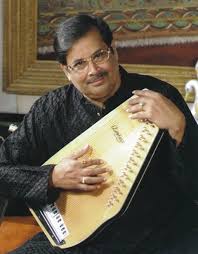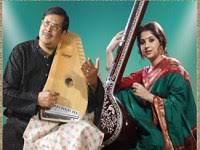Contribute
| Ten Questions For Padmashri Pandit Ajoy Chakraborty |
Shuchita Rao
10/18/2018
Padmashri Pandit Ajoy Chakraborty of the Patiala Gharana discussed his lineage and his music school for musically gifted children “Shrutinandan†in an exclusive interview recorded in 2010 when he visited Boston and performed for a concert and workshop organized by Swaralipi and Learnquest Academy of Music. The Kolkata based visiting artist is scheduled to perform on the evening of Saturday, November 3 at the Kresge Auditorium, MIT in a concert being arranged by MITHAS, PRABASI and LearnQuest Academy of Music. For tickets, please visit events.sulekha.com.
1. Do you believe that Indian Classical Music is niche music that cannot be enjoyed by the common man?
Absolutely not. In my performance in Boston, the audience liked my Khyaal presentation the best. Khyaal means thought and imagination. People all over the world have imagination. Take the case of Walt Disney – what glorious form he gave to a mouse based on the strength of his imagination. It is a matter of educating the common man to give wings to his imagination so he can understand and appreciate classical music.
2. Did you start learning music early in life? Who were your teachers/Gurus?
My father Late Shri Ajit Chakrabarty was my first teacher. Thereafter, I learned music from Shri Pannalal Samant and Late Shri Kanai Das Bairagi. The teacher who taught me to think was Padmabhushan Shri Jnan Prakash Ghosh. I learned specialized gharana music from Ustad Munawar Ali Khan, the son of the iconic and legendary late Ustad Bade Ghulam Ali Khan.
3. Did you start out with specific goals and a mission for your life?
I started out with wanting to be a “Gavaiyya†(versatile singer) . I changed my mission with the course of time. I want to give back to the society by teaching music. If Ajoy Chakrabarty does not sing, the world will not miss anything. But, if the uniqueness of our music is not conveyed to the world, something will definitely be missing. Not only do I want to give out this message, I want my students to propagate our music and its message.
4. You have been associated with India’s premier music institution ITC Sangeet Research academy for many years. In addition, you have started your own school of music Shrutinandan. What was the purpose of establishing a separate school?
Good question. ITC Sangeet research academy accepts only advanced students in music. I created Shrutinandan with a view to nurture musical talent in young children and to groom them to become advanced students of music. We accept only students in age group of 5 to 11 years after a strict audition process that filters out 90% to 95% of the applicants.
5. If you filter out 90% to 95% applicants, how do you console the children who have a deep desire to learn music but are not particularly suited to the training?
I explain to them that GOD sends everyone to earth with some sort of gift. It is for them to discover their unique gift that may not necessarily be music related. Children and parents do get disappointed in the process but they gradually understand the reasoning.
6. How many students study at Shrutinandan and are there any upcoming notable performers?
1500 students study at Shrutinandan. My daughter Kaushiki was what can be likened to the first guinea pig of the institution. Today, she is one of the most wanted musicians all over the world and sings traditional raag music. I have at least a dozen other talented youth who came to me between 5 and 11 years of age and sing with 100% confidence and maturity. We have engineers and doctors among our students who have opted to make a career in music.
First I teach students to understand musical note (swar) and relationships among musical notes.
Second, I want my students to understand the use of air and I teach them breathing exercises.
Third, I teach children to see their internal sense of time and teach them concepts of taal, laya and chhanda.
Fourth, I teach them to understand and appreciate lyrics.
Finally, I teach them to be good human beings and to develop sincerity to music.
I encourage students to learn not only Carnatic music but music from all over the world. Music from the South, West,East and North – every kind of music must be learned. I have a vision that one day just as the biggest source of power in the world, the mighty SUN rises in east and sets in the west , our training system will train musicians in eastern part of the world, India and come to the west to spread peace all over the world. There is no better art form than music that can touch your heart.
It is because of their own desire to serve music and the support of their parents. I tell them that we have only one life. Why become a company servant when you can serve GOD who is the biggest raja(king) of the world?
One starts out getting education at age 3 and it takes 30 years to become a doctor. When a student learns music, everyone expects him/her to become a Mozart or Beethoven or Lata Mangeshkar in one year. To train anyone to become a musician, you need to educate that person in a systematic, and scientific manner, then teach him/her to have humility(jhukaav) and the ability to think and discover what satisfies him/her. It takes a lifetime to cultivate these qualities. I am still learning music to this day.
You may also access this article through our web-site http://www.lokvani.com/

